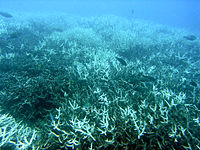
Photo from wikipedia
Abstract The 2014–2017 mass bleaching event is considered the third massive coral global bleaching event in recorded history. Based on the National Oceanic and Atmospheric Administration’s (NOAA) Coral Reef Watch… Click to show full abstract
Abstract The 2014–2017 mass bleaching event is considered the third massive coral global bleaching event in recorded history. Based on the National Oceanic and Atmospheric Administration’s (NOAA) Coral Reef Watch (CRW) product western India was under an alert level 2 (May–June 2015) with ten-Degree Heating Weeks (DHW) followed by level 1 (six-DHW) from October–November 2015. In succession to our regular surveys, we conducted intensive bleaching surveys following the bleaching alerts issued by NOAA to quantify the coral bleaching in Grande Island along the eastern Arabian sea during October–November2015. The in-situ observations of massive bleaching ( ∼ 50%) during the predicted bleaching period by NOAA CRW for the study area contrasted with a lower prevalence of bleaching before (6%) and after (8%) the event. Bleaching severity was highest in Porites spp. corals and the least in foliose Turbinaria mesenterina. The long-term effects of bleaching in this area remain to be seen. This study is the first record of massive bleaching and quantitative assessment in patchy reefs along the eastern Arabian Sea and would act as a baseline data for further reef studies.
Journal Title: Regional Studies in Marine Science
Year Published: 2020
Link to full text (if available)
Share on Social Media: Sign Up to like & get
recommendations!